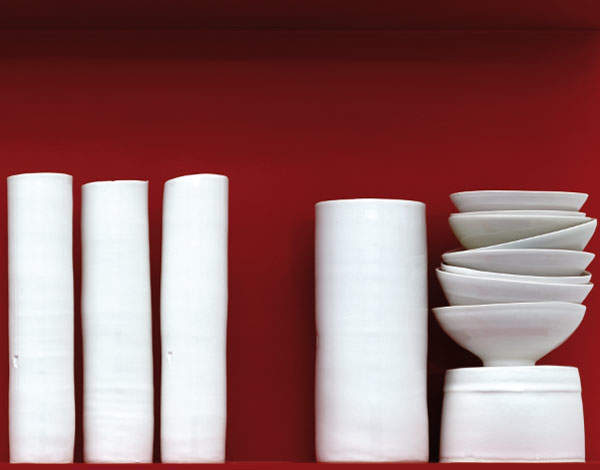

In the autumn of 1993, at the annual opening of the Chelsea Crafts Fair in Chelsea Town Hall, with its very mixed selection of ceramics, textiles, turned wood and artist-made jewellery, there was a new table. There, a tall, lean young man with expressive hands and an earnest expression had laid out a collection of beautiful soft porcelain pots.
Austerely minimal in form, these simple jugs, beakers and vases stood quietly radiant in their gleaming pale bluish-green celadon glaze. They looked quite unlike the brown stoneware pots of the Bernard Leach school of British pottery. But with their sometimes bashed-in sides, where a thumb might push them, and their homely functionalism, they also seemed far removed from the sculptural creations of artist potters like Hans Coper or Lucie Rie.
By the end of the day, this young potter, Cambridge-educated Edmund de Waal, had almost entirely sold out. The Crafts Council had bought work; he had been offered a show at Egg, the upmarket clothes shop in Belgravia; and the ceramics gallerist Anita Besson had made contact. As he puts it, ‘The overnightness was quite overwhelming.’ After seven years as an apprentice and a further four toiling in obscurity, de Waal’s ascent to the top of his calling had begun.
De Waal began his career in Canterbury, where his father was dean of the cathedral, committed to an ethic and an aesthetic of the humble domestic functional pot. In the words of de Waal’s first serious teacher, Geoffrey Whiting at King’s Canterbury, his pots should be ‘cheap enough to drop’.
Today de Waal is perhaps Britain’s most distinguished living potter. In May the art publisher Phaidon is bringing out a substantial monograph (to which I have contributed), while Turner Contemporary in Margate has unveiled a new commission, Atmosphere (until 8 February 2015), responding both to Turner and to the scene outside the gallery’s vast seaward window.
Alongside Grayson Perry, de Waal has brought pots out of the craft shop and into art galleries. From single functional pots, he has progressed to entire installations of his almost abstract white vessels, grouped in vitrines or open cabinets, the works’ poetic titles suggesting the cultural resonances he intends.

Today, these can fetch into seven figures. When the Victoria and Albert Museum wished to mark the refurbishment of its Contemporary ceramics galleries in the spaces either side of the dome that marks the heart of the museum, it turned to de Waal, who in 2009 created Signs and Wonders, a breathtaking lacquer-red aluminium circle carrying 425 porcelain vessels, positioned inside the dome itself.
Meanwhile, the craft-loving Duke and Duchess of Devonshire commissioned a permanent installation, a sounding line, for Chatsworth and in 2011 Jacob Rothschild invited de Waal to display his own work throughout the grand rooms of Waddesdon Manor, alongside paintings by Canaletto and Reynolds and masterpieces of Meissen and Sèvres porcelain.
Family affairs
However, although de Waal has become a significant figure in the Contemporary art world, he has become even better known as a writer. In 2010, de Waal’s family memoir The Hare with Amber Eyes became a global bestseller, taking everyone, including the author, by surprise.
Ostensibly this was the story of a collection of 264 Japanese netsuke — small, elaborately carved ivory or hardwood figurines — which de Waal had inherited from a great-uncle, Ignace (‘Iggy’) Ephrussi. These had originally been collected by de Waal’s great-great-grandfather Charles Ephrussi, scion of the Europe-wide Jewish banking family. In exploring the collection’s history, de Waal also dramatised a powerful family saga, which traced the Ephrussi story from the high point of the family’s fortunes in fin de siècle Paris and Vienna through the cataclysms of war to the present day.

The book is an irresistible page-turner, with your heart in your mouth as Europe’s dark night closes in on the family. But it is the huge themes explored in the book — memory, forgetting, the secret lives of objects, the hidden lives of families, the impact of loss, the passion for collecting, the transmission of culture from the past to the present through objects — and the elegance and energy of de Waal’s prose that have ensured its enduring success.
Creative streak
De Waal has always intertwined writing with making, using his gift with language both as critic and academic to clear a space for his original response to ceramic tradition. As he explains it, ‘My making and my writing is one thing. Pots turn into words, and words turn into pots.’ Indeed, writing Hare, far from driving de Waal from his throwing wheel, has unleashed a new and increasingly ambitious phase of creativity.
One response to the experience of reliving his family’s trauma of loss has been to relax the dogma of functional ceramics — that they should be part of the hurly-burly of domestic life, open to air and accident. Instead, in 2010, he began to use vitrines and cabinets and to explore, as he puts it, ‘the whole idea of independent structures which hold objects together in the world, and by holding, give them a place’.
The sequence of tremendous exhibitions of new work which has followed has shown him use his pots — whether sparsely grouped like figures in a painting or massed in myriad shades of white and grey; whether breathing freely on open shelves or protected within vitrines — to address an increasingly complex series of questions. These installations share more with contemporary poetry or serial music or minimalist sculpture than they do with kitchen porcelain.
For de Waal’s new installation in the Sunley Gallery at Turner Margate, just a few miles from Canterbury, where he grew up, there will be nine vitrines, holding 200 small celadon and grey porcelain vessels, suspended in space to catch the ever-changing light and to respond to, in his words, ‘this threshold between a building and the air outside’. These pots defy gravity. Their materiality has become immaterial — they are all air, all idea.






